
Ready to ditch the jarring jumps and bone-rattling runs? Low-impact exercises are here to save the day (and your joints)! Forget the image of boring, tedious workouts; we’re talking about a world of gentle movement that’s surprisingly effective. Whether you’re a seasoned athlete recovering from an injury or a couch potato looking for a kinder way to get fit, low-impact exercise offers a pathway to a healthier, happier you, without the need for a superhero cape.
This guide dives deep into the wonderful world of low-impact workouts, exploring everything from beginner-friendly routines to advanced strength training. We’ll uncover the secrets to maximizing calorie burn, improving cardiovascular health, and boosting your mood – all while keeping your body happy and injury-free. Prepare to discover a fitness revolution that’s as gentle as it is powerful.
Defining Low-Impact Exercises
So, you’re looking to get fit but your joints are screaming “Uncle!” before you even lace up your sneakers? Fear not, fellow fitness enthusiasts! Low-impact exercise is here to save the day (and your knees). We’re talking about workouts that are gentle on your body, minimizing stress on your joints while still providing a fantastic workout.Low-impact exercises are characterized by the minimal amount of force your body exerts on the ground during movement.
Think graceful gliding instead of jarring jumps. This doesn’t mean they’re a walk in the park (unless, of course, walking is your chosen activity!), but it does mean you can get a great workout without the post-exercise aches and pains that often accompany high-impact activities.
Types of Low-Impact Activities
A surprisingly diverse range of activities fall under the low-impact umbrella. These options cater to various fitness levels and preferences, ensuring there’s something for everyone, regardless of age or physical condition.
- Walking: A classic for a reason! A simple stroll can boost your cardiovascular health and strengthen your lower body. Imagine yourself strolling along a sun-drenched beach, the gentle sea breeze in your hair… now that’s low-impact motivation.
- Swimming: The water supports your body weight, making it incredibly gentle on your joints. Picture yourself effortlessly gliding through the water, feeling weightless and revitalized. It’s a full-body workout disguised as aquatic relaxation.
- Cycling: Whether you’re cruising on a stationary bike or exploring scenic routes outdoors, cycling is a fantastic low-impact cardio workout. Visualize yourself conquering a challenging hill, feeling the wind in your hair, and the burn in your legs – all without the joint stress.
- Yoga: This practice focuses on flexibility, strength, and balance, all while being incredibly gentle on your body. Envision yourself finding your inner peace as you gracefully move through a sun salutation, feeling your muscles stretch and strengthen.
- Pilates: Similar to yoga, Pilates emphasizes core strength and body control through slow, controlled movements. Picture yourself strengthening your core with focused movements, improving posture and balance with each controlled breath.
Benefits of Low-Impact Exercise
Low-impact exercise isn’t just for those recovering from injuries; it offers a plethora of benefits for people of all fitness levels.Low-impact exercises are fantastic for building strength and endurance without the jarring impact that can damage joints. For example, a regular walking program can significantly improve cardiovascular health and lower body strength in older adults, minimizing the risk of falls and improving overall mobility.
Similarly, Pilates is renowned for strengthening core muscles, which are crucial for maintaining good posture and reducing back pain – a common ailment regardless of age or fitness level. Even those already in excellent shape can benefit from incorporating low-impact activities for active recovery, preventing overuse injuries and promoting overall well-being.
Low-Impact vs. High-Impact Exercises
The key difference lies in the amount of force exerted on your joints. High-impact exercises, like running and jumping jacks, involve significant force with each repetition. This can be great for building bone density and improving cardiovascular fitness, but it also carries a higher risk of injury, especially for those with pre-existing joint issues. Low-impact exercises, on the other hand, minimize this force, making them a safer and more sustainable option for many.
Think of it like this: high-impact is a powerful punch, while low-impact is a gentle caress – both effective in their own way.
Low-Impact Exercises for Beginners
So, you’re ready to embark on your fitness journey, but the thought of high-impact workouts makes you want to hide behind a comfy cushion? Fear not, gentle warrior! Low-impact exercises are your secret weapon for building strength, improving endurance, and feeling fantastic without the jarring jumps and bone-rattling runs. We’re talking about a kinder, gentler approach to fitness that’s perfect for beginners, those recovering from injuries, or anyone who simply prefers a less strenuous workout.Low-impact exercises are a fantastic way to ease into fitness, building a solid foundation of strength and stamina without putting undue stress on your joints.
This approach is particularly beneficial for beginners who might be intimidated by more intense workouts. It allows you to focus on proper form and technique, preventing injuries and setting you up for long-term success. Remember, consistency is key, and low-impact exercises make it easier to stick to a regular fitness routine.
A Sample Beginner’s Low-Impact Workout Routine
This routine is designed to be completed 2-3 times per week, allowing for rest days in between to allow your body to recover. Remember to listen to your body and modify as needed.
| Exercise | Sets | Reps | Rest (seconds) |
|---|---|---|---|
| Wall Push-Ups | 3 | 10-12 | 30 |
| Chair Squats | 3 | 10-12 | 30 |
| Walking Lunges (stationary, no large step forward) | 3 | 10-12 per leg | 30 |
| Side-Lying Leg Raises | 3 | 10-12 per leg | 30 |
| Bird-Dog | 3 | 10-12 per side | 30 |
| Plank (modified on knees if needed) | 3 | 30 seconds | 45 |
Tips for Proper Form and Technique
Maintaining proper form is crucial for preventing injuries and maximizing the benefits of low-impact exercises. Imagine your body as a finely tuned machine – treat it with respect! Here are some key points:
- Engage your core: This stabilizes your body and protects your spine during exercises like squats and lunges. Think of drawing your belly button towards your spine.
- Maintain good posture: Stand tall with your shoulders relaxed and your back straight. Avoid hunching or slouching.
- Control your movements: Avoid jerky or bouncy movements. Move smoothly and deliberately, focusing on the muscles you’re working.
- Listen to your body: If you feel any pain, stop the exercise and rest. Don’t push yourself beyond your limits.
Modifications for Individuals with Specific Physical Limitations
Low-impact exercise is inherently adaptable, but modifications are crucial for those with specific needs. For example, individuals with knee problems might benefit from performing squats against a wall for support. Those with back issues could modify plank exercises by performing them on their knees. Always consult with a doctor or physical therapist before starting any new exercise routine, especially if you have pre-existing conditions.
A Visual Description of a Proper Warm-Up Routine
Imagine yourself gently waking up your muscles like a sleepy cat stretching. The warm-up should be 5-10 minutes of light cardio, such as a brisk walk or marching in place, followed by dynamic stretches. Visualize your arms swinging freely like windmills as you march, then gently rotating your shoulders forward and backward. Next, visualize your legs performing high knees and butt kicks, followed by gentle leg swings forward and backward, side to side.
Finally, picture yourself doing torso twists, reaching your arms towards the floor, and gently stretching your hamstrings by reaching for your toes. This prepares your body for the workout and reduces the risk of injury.
Low-Impact Exercises for Weight Management
Let’s face it, the idea of “weight management” often conjures images of grueling gym sessions and restrictive diets. But what if I told you that achieving your weight goals could involve less sweat and more…gentle swaying? Low-impact exercises, while not a magic bullet, are a surprisingly effective tool in your weight management arsenal. They offer a sustainable and kinder approach to fitness, perfect for beginners or those with joint issues, while still delivering significant results.Low-impact exercises contribute to weight management primarily through calorie burning and improved metabolism.
While they might not torch calories at the same rate as high-impact activities, the cumulative effect over time, combined with a balanced diet, can lead to significant weight loss and maintenance. The key is consistency and finding activities you genuinely enjoy, ensuring you stick with your workout plan. Think of it as a marathon, not a sprint – a slow and steady approach to a healthier you.
Effectiveness of Low-Impact Exercises in Weight Loss and Maintenance
Low-impact exercises are effective for weight loss and maintenance because they increase your overall energy expenditure. Activities like brisk walking, swimming, and cycling, when performed consistently, create a calorie deficit – the key to weight loss. Furthermore, these exercises improve cardiovascular health, boost metabolism, and build lean muscle mass, all contributing to a healthier body composition and easier weight management.
Studies show that individuals who incorporate regular low-impact exercise into their routines experience greater success in maintaining a healthy weight compared to those who are sedentary. For instance, a study published in the “Journal of Obesity” showed that participants who engaged in 30 minutes of brisk walking five days a week lost a significant amount of weight over a six-month period.
Sample Weekly Workout Plan Integrating Low-Impact Exercises for Weight Management
A successful weight management plan combines a balanced diet with regular exercise. Here’s a sample weekly plan incorporating low-impact activities, focusing on variety to prevent boredom and maximize results:
Remember to consult your doctor before starting any new exercise program.
- Monday: 30 minutes of brisk walking or cycling.
- Tuesday: 30 minutes of water aerobics or swimming.
- Wednesday: Rest or light stretching.
- Thursday: 30 minutes of yoga or Pilates.
- Friday: 30 minutes of elliptical training.
- Saturday: A longer, leisurely walk or hike (45-60 minutes).
- Sunday: Rest or active recovery (light stretching, gentle yoga).
Types of Low-Impact Exercises Most Beneficial for Burning Calories
While all low-impact exercises contribute to calorie burning, some are more effective than others. The calorie burn depends on factors like intensity, duration, and individual body weight. However, generally, activities that engage larger muscle groups tend to burn more calories.
- Swimming: A full-body workout that provides excellent cardiovascular conditioning and burns a significant number of calories.
- Cycling: A great option for lower body strength and cardiovascular health, burning a considerable amount of calories, especially at higher intensities.
- Elliptical Training: Mimics running but with less impact on the joints, offering a good calorie burn and a comprehensive workout.
Comparison of the Calorie Burn of Different Low-Impact Exercises
It’s important to remember that calorie burn is highly individual. Factors like weight, intensity, and duration significantly influence the results. However, we can provide a general comparison based on a person weighing approximately 150 pounds exercising for 30 minutes at a moderate intensity:
| Exercise | Approximate Calories Burned (30 minutes) |
|---|---|
| Brisk Walking | 150-200 |
| Cycling (moderate pace) | 180-250 |
| Swimming (moderate pace) | 250-350 |
| Elliptical Training (moderate intensity) | 200-300 |
| Yoga/Pilates | 100-150 |
Remember: These are estimates. Actual calorie burn can vary. Using a fitness tracker can provide a more personalized measurement.
Low-Impact Exercises for Improved Cardiovascular Health
Think of your heart as a finely tuned engine. It needs regular maintenance, and while high-impact workouts can be great, low-impact exercises offer a gentler, equally effective way to keep that cardiovascular engine purring like a kitten. They’re perfect for those looking to improve heart health without the jarring impact of running or jumping.Low-impact exercises improve cardiovascular health by strengthening the heart muscle, increasing its efficiency, and lowering resting heart rate.
These exercises improve blood circulation, helping to lower blood pressure and cholesterol levels. The sustained effort involved in low-impact cardio, even at a lower intensity, enhances the body’s ability to utilize oxygen, a key component of cardiovascular fitness. Think of it as a consistent, gentle massage for your circulatory system, leading to long-term benefits.
Benefits of Low-Impact Cardio for Individuals with Heart Conditions
Low-impact cardiovascular exercise offers a safe and effective way for individuals with heart conditions to improve their fitness levels. The reduced stress on joints and the controlled intensity allow for gradual improvement without exacerbating existing conditions. Always consult with a physician before starting any exercise program, especially if you have pre-existing heart conditions. A doctor can help determine a safe and appropriate exercise plan based on individual needs and limitations.
For example, a person recovering from a heart attack might start with very short sessions of walking, gradually increasing duration and intensity as their strength improves. The key is gradual progression, listening to your body, and prioritizing safety.
Sample Low-Impact Cardiovascular Workout Plan
This sample plan is a suggestion and should be adjusted to your fitness level and any health concerns. Remember to consult your doctor before beginning any new workout routine.
This plan focuses on building endurance over time. Each session should be preceded by 5 minutes of light warm-up activities, such as arm circles and leg swings, and followed by 5 minutes of cool-down stretching.
| Day | Activity | Duration | Intensity |
|---|---|---|---|
| Monday | Brisk Walking | 20 minutes | Moderate (able to hold a conversation) |
| Tuesday | Water Aerobics | 30 minutes | Moderate to Vigorous (slightly breathless) |
| Wednesday | Rest or Light Stretching | – | – |
| Thursday | Cycling (stationary bike) | 25 minutes | Moderate |
| Friday | Swimming (low-impact strokes) | 30 minutes | Moderate to Vigorous |
| Saturday | Yoga or Pilates | 45 minutes | Low to Moderate |
| Sunday | Rest or Active Recovery (light walk) | – | – |
Gradually increase the duration and intensity of your workouts as you get fitter. Remember to listen to your body and take rest days when needed.
Monitoring Heart Rate During Low-Impact Cardiovascular Exercise
Monitoring your heart rate is crucial for ensuring you’re exercising at the right intensity. Using a heart rate monitor or simply checking your pulse (at your wrist or neck) can help you stay within your target heart rate zone. This zone is typically calculated as a percentage of your maximum heart rate (220 minus your age). For improving cardiovascular health, aim for the moderate-intensity range, usually 50-70% of your maximum heart rate.
If you’re new to exercise or have heart conditions, it’s best to start at the lower end of this range and gradually increase the intensity as you become fitter. Remember, the goal is consistent effort, not pushing yourself to exhaustion. Paying attention to your body’s signals—such as shortness of breath or chest pain—is paramount. Stop exercising immediately if you experience any discomfort and consult your doctor.
Low-Impact Exercises and Mental Well-being

Let’s face it, life can feel like a relentless game of whack-a-mole sometimes. Stress, anxiety, and even the occasional bout of the blues can leave us feeling utterly depleted. But what if I told you there’s a surprisingly simple, low-impact way to combat these mental foes? Enter the wonderful world of gentle exercise – a secret weapon for a happier, healthier you.
Low-impact workouts aren’t just about physical fitness; they’re a powerful tool for nurturing your mental well-being, too.Low-impact exercise offers a potent cocktail of benefits for your mental health. The rhythmic nature of many of these activities, combined with the release of endorphins, creates a powerful synergy that tackles stress head-on. This isn’t just about feeling less stressed; we’re talking about a genuine improvement in mood, a sharper mind, and a more resilient spirit capable of handling life’s inevitable curveballs with greater grace.
The link between physical activity and mental clarity is undeniable, and low-impact exercise provides a gentle, accessible pathway to unlock that clarity.
Mindful Movement Practices Incorporating Low-Impact Exercises
Mindful movement seamlessly blends physical activity with mental focus, creating a holistic approach to well-being. It’s about connecting with your body and your breath, paying attention to the sensations of movement without judgment. This conscious engagement helps to quiet the mental chatter that often fuels stress and anxiety.Examples of mindful movement incorporating low-impact exercises include Tai Chi, where slow, deliberate movements promote relaxation and balance; Yoga, which combines postures, breathing techniques, and meditation to calm the mind and increase flexibility; and even a simple mindful walk in nature, focusing on the feel of the ground beneath your feet and the rhythm of your breathing.
Imagine the feeling of sunlight warming your skin, the gentle breeze on your face, and the sounds of nature all while engaging in a gentle, low-impact activity.
The Connection Between Physical Activity and Mental Clarity
Regular physical activity, particularly low-impact exercises, has been shown to boost cognitive function. It’s not just about feeling good; it’s about thinking better. Low-impact exercise improves blood flow to the brain, delivering vital oxygen and nutrients that fuel mental clarity and focus. This increased blood flow also helps to clear out metabolic waste products that can hinder cognitive performance.
Studies have shown improvements in memory, attention span, and overall cognitive function in individuals who engage in regular low-impact exercise. Think of it as giving your brain a refreshing spring cleaning!
Low-Impact Exercise in Managing Anxiety and Depression
The role of low-impact exercise in managing anxiety and depression is significant. While not a replacement for professional treatment, regular physical activity can be a powerful adjunct therapy. Low-impact exercise helps regulate neurotransmitters like serotonin and dopamine, which play crucial roles in mood regulation. The sense of accomplishment derived from completing a workout, no matter how small, can boost self-esteem and reduce feelings of helplessness often associated with anxiety and depression.
Moreover, the rhythmic nature of many low-impact exercises can create a meditative effect, helping to calm racing thoughts and reduce feelings of overwhelm. Think of it as a gentle, yet effective, way to re-wire your brain for a more positive outlook. For example, a consistent routine of gentle swimming or water aerobics has been shown to positively impact individuals struggling with anxiety and depression.
Health Fitness Considerations for Low-Impact Exercise
Low-impact exercise, while gentler on the joints, still requires careful consideration to maximize benefits and minimize risks. Many people harbor misconceptions about its effectiveness, leading to improper execution and potentially disappointing results. Understanding these nuances is key to reaping the rewards of a low-impact fitness routine.
Common Misconceptions about Low-Impact Exercise
Let’s bust some myths! A common misconception is that low-impact exercise is only for the elderly or injured. In reality, it’s a fantastic option foreveryone*, from seasoned athletes looking for active recovery to beginners just starting their fitness journey. Another fallacy is that low-impact workouts are inherently less effective. While they might not pack the same punch as high-impact exercises in terms of calorie burn in a short period, their sustained nature and reduced risk of injury allow for more frequent and consistent exercise, leading to significant long-term benefits.
Finally, some believe that low-impact means “no effort.” While it’s gentler, low-impact workouts can still challenge your cardiovascular system and build strength – just at a more sustainable pace.
Appropriate Footwear and Clothing for Low-Impact Activities
Choosing the right gear is crucial. For footwear, supportive sneakers with good cushioning are essential. Avoid flimsy flats or worn-out shoes that lack arch support. The goal is to minimize stress on your joints and provide stability. Imagine your feet as the foundation of your movement; a strong foundation needs strong support.
As for clothing, opt for breathable fabrics that wick away sweat to keep you comfortable and prevent chafing. Layers are also a good idea, allowing you to adjust as your body temperature changes during your workout. Think moisture-wicking fabrics like polyester or blends that incorporate those fibers. Avoid cotton, which tends to retain moisture.
Recognizing Signs of Overexertion
Listening to your body is paramount. Ignoring warning signs can lead to injury and derail your progress. Pay attention to pain – sharp, stabbing pain is a definite stop signal. Muscle soreness is normal, but excessive or persistent pain is not. Other signs of overexertion include dizziness, nausea, shortness of breath, and extreme fatigue.
Remember, a good workout shouldn’t leave you feeling completely wiped out for days; it should leave you feeling energized and accomplished. If you experience any of these symptoms, stop your workout and rest.
Importance of Proper Hydration and Nutrition
Hydration is key for any physical activity, low-impact or otherwise. Dehydration can lead to fatigue, muscle cramps, and decreased performance. Aim to drink plenty of water before, during, and after your workout. The amount will vary based on factors like intensity and duration, but a general guideline is to drink water throughout the day and especially before, during, and after your workout.
Nutrition also plays a crucial role. Fueling your body with a balanced diet rich in fruits, vegetables, and lean protein provides the energy needed for sustained exercise and aids in muscle recovery. Think of your body like a car; it needs the right fuel to perform optimally. Avoid sugary drinks and processed foods that can lead to energy crashes and hinder your performance.
Wrap-Up

So there you have it – a comprehensive guide to unlocking the amazing potential of low-impact exercise. From gentle starts to challenging routines, the possibilities are endless. Remember, the key is consistency and listening to your body. Embrace the low-impact life, and watch as your fitness journey becomes a joy, not a chore. Now go forth and gently conquer your fitness goals!
FAQ Explained
Are low-impact exercises only for older people or those with injuries?
Absolutely not! Low-impact workouts are beneficial for people of all ages and fitness levels. They’re a fantastic way to start exercising, build a base fitness, or modify existing routines to prevent injury.
How often should I do low-impact exercises?
Aim for at least 150 minutes of moderate-intensity low-impact cardio per week, spread across several days. Strength training should be incorporated at least twice a week.
Can I lose weight with only low-impact exercises?
While low-impact exercise alone might not lead to drastic weight loss, it’s a crucial component of a healthy weight management plan. Combine it with a balanced diet for optimal results.
What if I get bored with low-impact exercises?
Variety is key! Explore different low-impact activities like swimming, yoga, cycling, or dancing. Mix up your routines to keep things interesting and challenge your body in new ways.





